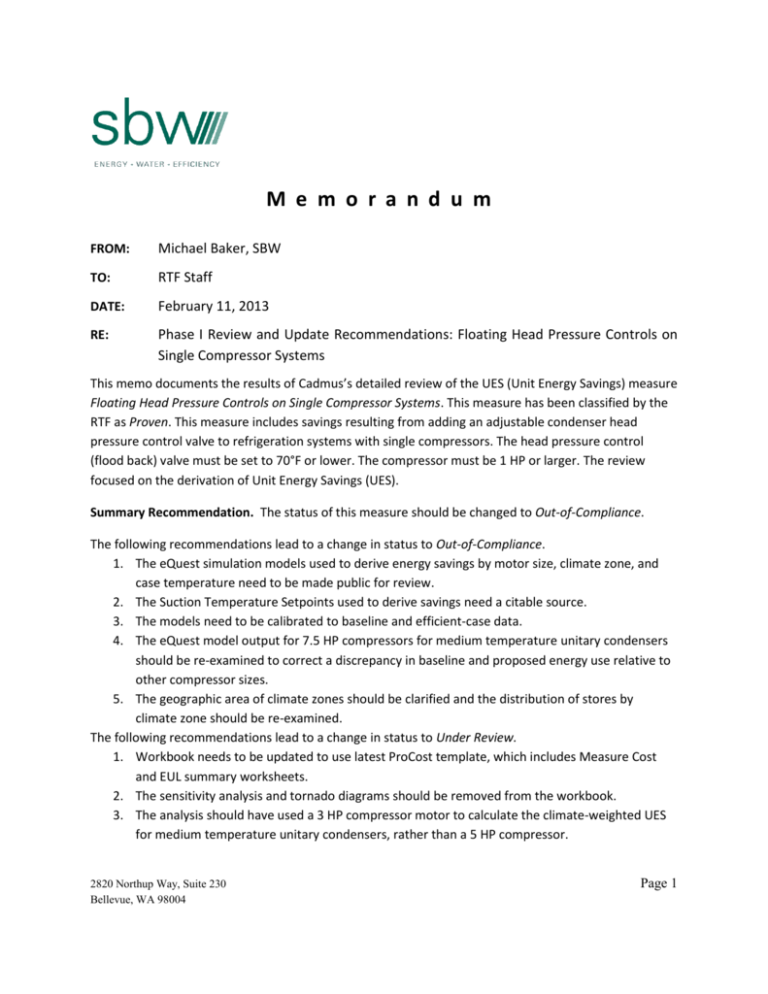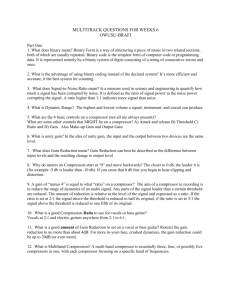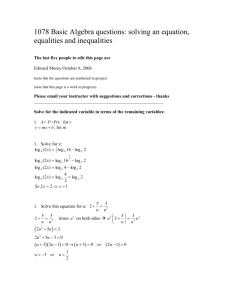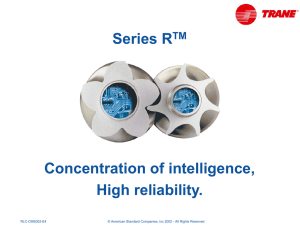The status of this measure should be changed to Out-of
advertisement

M e m o r a n d u m FROM: Michael Baker, SBW TO: RTF Staff DATE: February 11, 2013 RE: Phase I Review and Update Recommendations: Floating Head Pressure Controls on Single Compressor Systems This memo documents the results of Cadmus’s detailed review of the UES (Unit Energy Savings) measure Floating Head Pressure Controls on Single Compressor Systems. This measure has been classified by the RTF as Proven. This measure includes savings resulting from adding an adjustable condenser head pressure control valve to refrigeration systems with single compressors. The head pressure control (flood back) valve must be set to 70°F or lower. The compressor must be 1 HP or larger. The review focused on the derivation of Unit Energy Savings (UES). Summary Recommendation. The status of this measure should be changed to Out-of-Compliance. The following recommendations lead to a change in status to Out-of-Compliance. 1. The eQuest simulation models used to derive energy savings by motor size, climate zone, and case temperature need to be made public for review. 2. The Suction Temperature Setpoints used to derive savings need a citable source. 3. The models need to be calibrated to baseline and efficient-case data. 4. The eQuest model output for 7.5 HP compressors for medium temperature unitary condensers should be re-examined to correct a discrepancy in baseline and proposed energy use relative to other compressor sizes. 5. The geographic area of climate zones should be clarified and the distribution of stores by climate zone should be re-examined. The following recommendations lead to a change in status to Under Review. 1. Workbook needs to be updated to use latest ProCost template, which includes Measure Cost and EUL summary worksheets. 2. The sensitivity analysis and tornado diagrams should be removed from the workbook. 3. The analysis should have used a 3 HP compressor motor to calculate the climate-weighted UES for medium temperature unitary condensers, rather than a 5 HP compressor. 2820 Northup Way, Suite 230 Bellevue, WA 98004 Page 1 Limitation of Review. None. Alterations to Workbook and Documentation. Since the measure definition stated compressors must be 1 HP or larger, in the worksheet “CondUnit Weighted Savings”, references to 0.5 HP compressors were removed. Corrected misspellings and grammatical errors. The worksheet “Measure_InputOutput” contained numerous rows for compressor motor size iterations that were not used in final UES estimates. Unused rows were removed. On the worksheets “CondUnit Sensitivity Analysis” and “Remote Sensitivity Anal,” the maximum compressor oversizing is listed as 120%, while the typical value is listed as 130%. Values were reversed so they were in appropriate cells. Workbook Calculation Errors. a) No calculation errors were found. Recommendations for Updates. The RTF should implement the following recommendations. 1) Workbook Structure and Formulas b) Update workbook with latest ProCost template to include Measure Cost and Effective Useful Life (EUL) summary worksheets. This deficiency causes the measure status to change to Under Review. c) On worksheet “CondUnit Sensitivity Analysis” an analyst notes “some errors were found in the modeling method used in the sensitivity analysis which is why the ‘typical’ values from tornado diagrams do not match final savings values.” As an example, the medium temperature unitary condenser tornado diagram used 3 HP as the typical compressor motor size, although the analysis used a 5 HP compressor. The typical energy savings in each tornado diagram is significantly different from the final UES value (for example, 315 kWh in the medium temperature unitary tornado diagram versus the final UES of 757 kWh). Since these types of analysis are not valid UES analysis mythologies, these worksheets should be removed from the workbook. This deficiency causes the measure status to change to Under Review. 2) Documentation a) The review team did not have access to the eQuest simulation models used to derive energy savings by Compressor Size, climate zone, and case temperature. The review team also did not have access to the GrocerSmart database that identified the frequency of Compressor Size by case temperature and distribution of stores by climate zones. The workbook also Page 2 does not list the source and geographic range of climate zones use to determine Climate Weighting Factors. Those do not match the climate zone maps with which the review team typically works, such as ones produced by the RTF1 or Pacific Northwest National Laboratory2. Therefore, the review team could not confirm the accuracy of this data due to lack of documentation. This deficiency causes the measure status to change to Out-ofCompliance. b) The analysis cites the following Suction Temperature Setpoints. However, the source of these set points is not cited. This deficiency causes the measure status to change to Out-ofCompliance. a. Condensing Unit MT: 12°F b. Condensing Unit LT: -23°F c. Remote Condenser MT: 17°F d. Remote Condenser LT: -20°F 3) Measure Definition a) No changes recommended. 4) UES Savings Estimation Method a) The analyst calculated the motor-weighted energy savings for medium temperature unitary condenser at 803 kWh per year. The analyst then used eQuest runs with a 5 HP compressor to calculate the climate-weighted UES value for this measure. As shown in Table 1 below, the closest value to the motor-weighted savings was the 3 HP compressor, not the 5 HP compressor. Based on the results, the 5 HP compressor savings may have been selected as the more conservative value since they are less than those for the 3 HP compressor. However, this is not indicated in the documentation, which only stated the 5 HP motor “most closely matched the weighted motor savings.” The review team recommends the compressor size used to calculate the climate-weighted UES for medium temperature unitary condensers be changed to 3 HP. This deficiency causes the measure status to change to Under Review. Table 1. Variance from Weighted Energy Savings by Compressor Size Compressor HP 1 2 3 5 7.5 10 Baseline Energy Use (kWh) 85,607 119,886 132,159 143,527 121,550 167,471 Proposed Energy Use (kWh) 85,095 118,024 129,679 139,725 114,943 160,136 Energy Savings (kWh) 512 931 826 760 881 733 Variance from Weighted Energy Savings -36% 16% 3% -5% 10% -9% 1 http://www.nwcouncil.org/energy/rtf/zones/regional_hot.pdf 2 http://apps1.eere.energy.gov/buildings/publications/pdfs/building_america/ba_climateguide_7_1.pdf Page 3 b) The review team noted the analyst derived UES values from the difference in total store energy use between the eQuest baseline and proposed models with a single compressor per store, an unlikely scenario for an actual grocery store. The simulation model required artificial constraints on case size and refrigeration energy for appropriate scaling. The resulting modeled annual store energy use is less than the average monthly utility bill for an actual grocery store. The guidelines require that simulation models be calibrated to pre and post-installation data. This deficiency causes the measure status to change to Out-ofCompliance. 5) Input Parameters a) The review team identified a discrepancy in the eQuest output for 7.5 HP compressors for medium temperature unitary condensers. Compressor Size was the primary eQuest model input that varied between iterations. As compressor HP increases, annual energy use should increase, as shown in Table 1. The review team noted the 7.5 HP compressor baseline and proposed energy use decreased over the outputs for the 5 HP compressor. This variance indicated a potential deficiency in the simulation model assumptions for the 7.5 HP compressor. The review team recommends investigating the model input parameters to determine whether the annual energy use should be higher. This deficiency causes of the measure status to change to Out-of-Compliance. b) The Climate Weighting relied on GrocerSmart database counts of stores in the Pacific Northwest by region and climate zone. The Seattle UES value is the largest, and also has the highest proportion of the overall store population (and therefore the highest weighting). As noted earlier, the climate zone definitions do not match any with which the review team is familiar. Therefore, it is not clear what total geographic area each climate zone represents. The GrocerSmart data indicated 2,938 stores were located in the Seattle region (Zone 22) and 999 were located in the Portland region (Zone 20), a ratio of 2.9 to 1. The review team reviewed demographic information and determined the Puget Sound region (Seattle, Tacoma, Olympia, and adjacent urban areas) has a population of 4,269,349 people1, while the Portland metropolitan area (Portland, Vancouver, Hillsboro, and adjacent urban areas) has a population of 2,262,605 people2, a ratio of 1.9 to 1. Without knowledge of the specific geographic regions encompassing each climate zone, the review team considered it unlikely that a region with only twice the population would have nearly three times the number of stores as another region. The review team could not confirm the accuracy of this data. This deficiency causes the measure status to change to Out-of-Compliance. Additional Considerations. None. 1 http://www.census.gov/popest/data/metro/totals/2011/tables/CBSA-EST2011-02.csv 2 http://www.census.gov/popest/data/metro/totals/2011/tables/CBSA-EST2011-01.csv Page 4 Page 5





